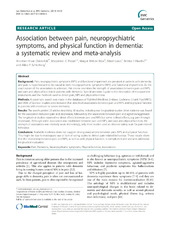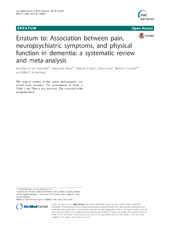| dc.contributor.author | van Dalen-Kok, Annelore H. | en_US |
| dc.contributor.author | Pieper, Marjoleine J.C. | en_US |
| dc.contributor.author | de Waal, Margot W.M. | en_US |
| dc.contributor.author | Lukas, Albert | en_US |
| dc.contributor.author | Husebø, Bettina | en_US |
| dc.contributor.author | Achterberg, Wilco P. | en_US |
| dc.date.accessioned | 2015-12-10T10:12:37Z | |
| dc.date.available | 2015-12-10T10:12:37Z | |
| dc.date.issued | 2015-04-19 | |
| dc.Published | BMC Geriatrics 2015, 15:49 | eng |
| dc.identifier.issn | 1471-2318 | |
| dc.identifier.uri | https://hdl.handle.net/1956/10731 | |
| dc.description | Erratum published: BMC Geriatrics. 2015 Sep 09;15(1):109 | |
| dc.description.abstract | Background Pain, neuropsychiatric symptoms (NPS) and functional impairment are prevalent in patients with dementia and pain is hypothesized to be causal in both neuropsychiatric symptoms (NPS) and functional impairment. As the exact nature of the associations is unknown, this review examines the strength of associations between pain and NPS, and pain and physical function in patients with dementia. Special attention is paid to the description of measurement instruments and the methods used to detect pain, NPS and physical function. Methods A systematic search was made in the databases of PubMed (Medline), Embase, Cochrane, Cinahl, PsychINFO, and Web of Science. Studies were included that described associations between pain and NPS and/or physical function in patients with moderate to severe dementia. Results The search yielded 22 articles describing 18 studies, including two longitudinal studies. Most evidence was found for the association between pain and depression, followed by the association between pain and agitation/aggression. The longitudinal studies reported no direct effects between pain and NPS but some indirect effects, e.g. pain through depression. Although some association was established between pain and NPS, and pain and physical function, the strength of associations was relatively weak. Interestingly, only three studies used an observer rating scale for pain-related behaviour. Conclusions Available evidence does not support strong associations between pain, NPS and physical function. This might be due to inadequate use or lack of rating scales to detect pain-related behaviour. These results show that the relationship between pain and NPS, as well as with physical function, is complicated and warrants additional longitudinal evaluation. | en_US |
| dc.language.iso | eng | eng |
| dc.publisher | BioMed Central | eng |
| dc.rights | Attribution CC BY | eng |
| dc.rights.uri | http://creativecommons.org/licenses/by/4.0 | eng |
| dc.subject | Pain | eng |
| dc.subject | Neuropsychiatric symptoms | eng |
| dc.subject | Dementia | eng |
| dc.title | Association between pain, neuropsychiatric symptoms, and physical function in dementia: a systematic review and meta-analysis | en_US |
| dc.type | Peer reviewed | |
| dc.type | Journal article | |
| dc.date.updated | 2015-11-06T11:57:38Z | |
| dc.description.version | publishedVersion | en_US |
| dc.rights.holder | Copyright van Dalen-Kok et al.; licensee BioMed Central. 2015 | |
| dc.identifier.doi | https://doi.org/10.1186/s12877-015-0048-6 | |
| dc.identifier.cristin | 1245493 | |
| dc.subject.nsi | VDP::Medisinske fag: 700::Helsefag: 800::Epidemiologi medisinsk og odontologisk statistikk: 803 | |
| dc.subject.nsi | VDP::Midical sciences: 700::Health sciences: 800::Epidemiology, medical and dental statistics: 803 | |
| dc.subject.nsi | VDP::Medisinske Fag: 700 | en_US |


